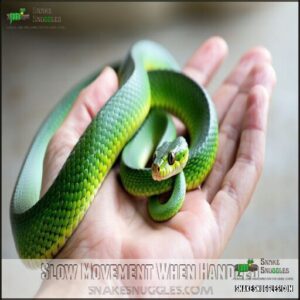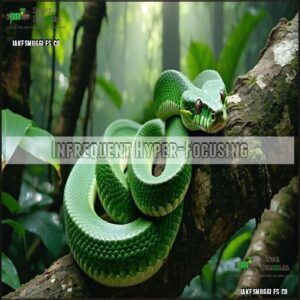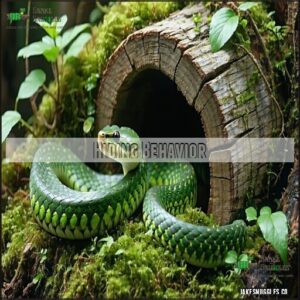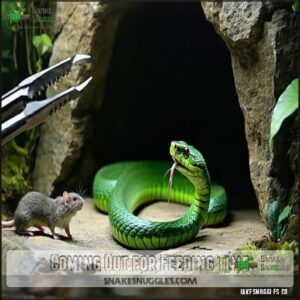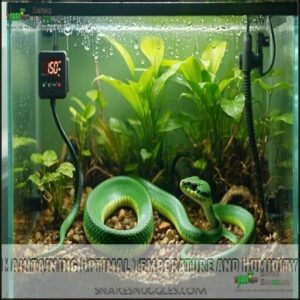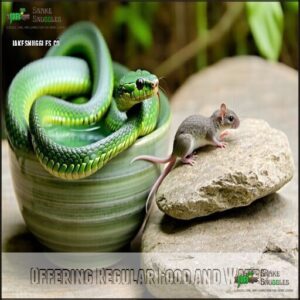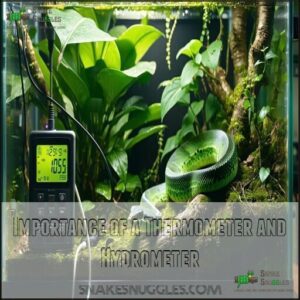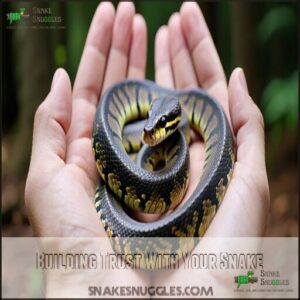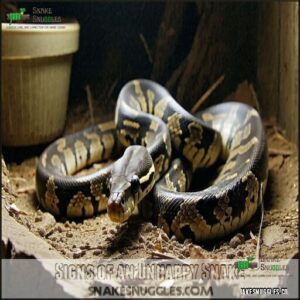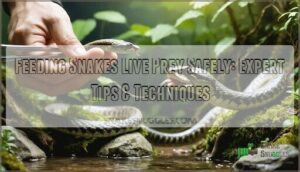This site is supported by our readers. We may earn a commission, at no cost to you, if you purchase through links.
 You’re wondering how to tell if a snake is happy, and it’s great that you’re thinking about your pet’s well-being.
You’re wondering how to tell if a snake is happy, and it’s great that you’re thinking about your pet’s well-being.
To determine if a snake is happy, you should observe its behavior and body language, looking for signs like slow movement when handled, infrequent hyper-focusing, and contentment in its surroundings.
A happy snake will also have a healthy appetite and thrive in its environment, which is a key indicator of its overall well-being, and by recognizing these signs, you can confirm your pet snake is living its best life.
By creating a happy and healthy home for your slithery friend, there’s more to learn about providing the right conditions for it to flourish, and understanding these aspects is crucial for its happiness and well-being.
Table Of Contents
- Key Takeaways
- Recognizing a Happy Snake
- Signs of a Happy Snake
- Creating a Conducive Habitat
- Building Trust With Your Snake
- Signs of an Unhappy Snake
- Common Health Issues in Snakes
- Handling and Interacting With Your Snake
- Frequently Asked Questions (FAQs)
- How do you know if a snake is happy?
- How do you know if a snake is healthy?
- Are snakes happy?
- How do you know if a pet snake is comfortable?
- How can you tell if a snake is stressed?
- How do you know if a snake has a healthy appetite?
- Can you tell if a snake is happy?
- What do snakes do when they are happy?
- How can you tell if a snake is happy?
- How to keep a snake happy?
- Conclusion
Key Takeaways
- You’ll know if your snake is happy by observing its relaxed movements, normal eating habits, and calm demeanor, which indicate contentment and trust in its environment.
- To keep your snake happy, you’ll need to provide proper care, housing, and diet, ensuring a clean enclosure and handling it gently to create a comfortable environment that meets its physical and emotional needs.
- You can tell if your snake is stressed by watching for signs like hissing, striking, or fleeing, which indicate its environment or care is inadequate, so it’s crucial to monitor behavior closely to identify potential issues early.
- By recognizing key signs of happiness, such as slow movement when handled, infrequent hyper-focusing, and contentment in its surroundings, you’ll be able to guarantee your pet’s well-being and help it live its best life.
Recognizing a Happy Snake
Understanding your snake’s behavior is key to ensuring its well-being and comfort.
Know your snake’s behavior for a happy and comfortable pet
By recognizing signs like relaxed movements, regular exploration, and calm body language, you can determine if your snake feels secure and happy in its environment, which is crucial for its overall well-being.
Signs of a Relaxed Snake
When your snake feels at ease, it shows through relaxed body language that’s easy to spot if you know what to look for.
A relaxed snake is a happy snake, showing calm body language and gentle movements.
Here are four telltale happy snake signs:
- Relaxed grip: Loose coils with soft, natural body curves, not tight or rigid.
- Calm demeanor: Steady breathing without sudden movements screams comfort.
- Slow movement: Unhurried exploration reflects trust in its surroundings.
- Casual tonguing: Gentle, rhythmic tongue flicks indicate curiosity and safety.
These behaviors signal a calm snake enjoying a stress-free environment!
Normal Behavior and Body Language
Understanding snake body language offers key insights into snake happiness. A content snake shows relaxed movements with loose, fluid body posture instead of tight coils.
During handling, its grip is calm, never constricting. Gentle and rhythmic tongue flicking suggests curiosity, not anxiety. While exploring, you’ll see slow, steady movements reflecting ease.
Here’s a handy snapshot:
| Behavior | Indicates Relaxation | Signals Stress | What to Watch For |
|---|---|---|---|
| Body Posture | Loose, natural curves | Tightly coiled | Lack of fluidity |
| Tongue Flicking | Gentle, deliberate | Rapid or absent | Changes in frequency |
| Exploration Habits | Slow, deliberate movements | Hyperactive or static | Inconsistent reactions |
| Grip During Handling | Casual, not tight | Tight or shaky | Over-constriction |
Observe these behavior signs to nurture your snake’s security and trust.
Importance of a Stress-Free Environment
A stress-free environment is the cornerstone of your snake’s well-being.
When their habitat feels secure, they can truly thrive, showing classic snake happiness indicators like calm movement and relaxed body curves.
Focus on these four essentials to create their sanctuary:
- Enclosure Size: Verify the habitat is at least 1.5 times your snake’s length for proper movement.
- Temperature Gradients: Maintain a species-specific range for basking and cooling.
- Hiding Spots: Provide multiple shelters using cork bark, logs, or commercial hides to mimic natural comfort zones.
- Quiet Placement: Situate the enclosure away from noisy household areas to reduce stress.
This balance of comfort and security promotes snake wellbeing and minimizes stress signs.
Signs of a Happy Snake
Understanding how your snake behaves when it’s content can help you guarantee its well-being. A happy snake shows subtle signs, like relaxed movements and curiosity about its surroundings.
Slow Movement When Handled
When your snake rests softly in your hands, moving with calm, slow movements, you’re witnessing a happy, relaxed snake.
A comfortable grip, where the snake wraps loosely rather than squeezing, shows it feels secure in your presence.
| Behavior | What It Means |
|---|---|
| Relaxed Grip | Safety and comfort |
| Soft Wrapping | No threat detected |
| Gentle Handling | Trust in human |
| Calm Movements | Relaxation indicators |
These signs highlight a snake’s contentment during handling.
By approaching with patience and gentle handling, you’re building trust, ensuring both the snake’s comfort and happiness.
Infrequent Hyper-Focusing
A relaxed snake rarely hyper-focuses. Instead, they exhibit subtle relaxation indicators like smooth movements and casual tongue flicking.
This behavior signals they’re comfortable and stress-free in their environment, showing handling comfort and environmental ease.
Infrequent hyper-focusing is a sign of stable personality and security signals—key components of snake happiness. Happy snakes move slowly, exploring their surroundings with steady, deliberate actions rather than sharp or frantic responses.
On the other hand, stress presents differently. During your snake behavior observations, watch for signs like:
- Tense coils instead of loose, natural curves.
- Frantic tongue flicking, signaling discomfort.
- Straightened focus on escape routes, indicating unease.
- Heightened alertness, such as fixed staring or quick movements.
By identifying these snake contentment traits, you’ll recognize when they feel secure. A balanced, curious demeanor shows they’re thriving—not just surviving—in their habitat.
Hiding Behavior
A secure hiding spot is a must for stress reduction and snake contentment.
When your snake curls up in its favorite hide, it’s not being antisocial—it’s following natural instincts to stay safe and comfortable.
Well-placed hides in an enclosure design create a sanctuary, fostering snake happiness.
Pay attention to hiding behavior; steady use of these spaces often signals snake comfort, as they rely on familiar, secure areas for relaxation and peace.
Coming Out for Feeding Time
Meal times can reveal a lot about your snake’s happiness. When your pet comes out for feeding, it’s a sign of trust and comfort in its environment. Their behavior gives you valuable insights into their well-being.
You’ll notice Pre-Feed Cues like tongue flicking and an alert posture when food is near. A happy snake shows strong Feeding Response Strength, confidently approaching prey in a smooth, deliberate way, without hesitation. Their Enclosure Approach Style during feeding is key—no frantic strikes or timid movements, just steady focus.
A consistent feeding schedule signals snake happiness and a healthy appetite. Keep an eye on their Post-Feed Behavior too. Resting calmly after eating, instead of displaying stress, confirms your snake feels secure.
- Pre-Feed Cues: Tongue flicking and alert movements
- Smooth Feeding Response: Confidence during meals
- Post-Feed Calmness: Relaxed and content demeanor
Contentment in Its Surroundings
A snake that’s happy in its habitat shows it through relaxed exploration and curiosity.
You’ll see slow, deliberate movements and gentle tongue flicks as it navigates its enclosure, investigating decorations, climbing structures, or basking spots.
Balanced shifts between basking and hiding indicate strong environmental security—a key snake contentment indicator.
Enhance their happiness with enclosure enrichment, like adding branches or hide options, to encourage natural behaviors.
Avoid sudden changes that could disrupt their comfort zone.
A content snake thrives in a habitat designed with the right mix of complexity and reducing stressors, making their home the perfect place for them to be.
Creating a Conducive Habitat
Your snake’s happiness starts with a well-designed habitat that meets its natural needs.
By adjusting the enclosure’s size, temperature, and features, you’ll help create a space where your pet feels secure and comfortable.
Providing a Spacious Enclosure
A proper enclosure is the backbone of your snake’s comfort and happiness. To guarantee your pet thrives, consider the right tank size and thoughtful design. Start with an enclosure size that’s at least 1.5 times your snake’s length, giving them space to stretch out and move naturally.
Incorporate key snake environmental enrichment elements to encourage healthy, stress-free behaviors. Here’s how you can achieve it:
- Hiding Spots: Place multiple hides on both the warm and cool sides for security and temperature regulation.
- Climbing Structures: Add branches, rocks, or ledges so your snake can explore and exhibit natural behaviors.
- Substrate Choice: Use varied substrates to stimulate curiosity while maintaining a clean, comfortable environment.
These features create a habitat that lets your snake enjoy essential snake happiness indicators, such as curiosity and relaxed movement. Determining you have the appropriate enclosure dimensions is vital for their well-being. A well-designed snake habitat equals a healthy, happy companion!
Maintaining Optimal Temperature and Humidity
To keep your snake comfortable and healthy, maintaining optimal temperature and humidity is essential.
Snakes rely on proper heating gradients and humidity levels for temperature regulation and hydration. Aim for these key conditions:
- Heating gradients: Keep cool zones between 75-85°F and warm areas around 85-95°F to support natural thermoregulation.
- Humidity levels: Maintain 40-60% for most species, with adjustments for tropical breeds needing higher levels.
- Monitoring equipment: Use digital thermometers and hygrometers to guarantee accuracy and consistency.
- Seasonal adjustments: Tailor climate control to match changing weather, preventing stress from extreme conditions.
Proper setup requires a suitable thermal gradient. Create a balanced habitat, and you’ll notice key snake happiness indicators like relaxed movement and natural curiosity!
Offering Regular Food and Water
Meeting your snake’s basic needs, like food and water, is essential for their health and well-being.
A consistent feeding and hydration routine promotes stability, making your snake more comfortable and content.
Here’s how to guarantee proper snake care:
- **Feeding frequency matters.
Adult snakes generally eat every 5-7 days, but juveniles may need feeding more often. Stick to a schedule suited to your species.
- **Keep water fresh.
Replace it daily to maintain water quality and prevent dehydration, which can affect shedding and overall health.
- **Size matters with prey.
Choose prey items appropriate for your snake’s size, ensuring easier digestion and maintaining a healthy appetite.
When you meet their hydration methods and nutritional needs, your snake will show healthy eating habits—clear snake happiness indicators!
Providing Hiding Places and Climbing Structures
Creating a habitat with hiding spots and climbing structures boosts snake happiness indicators and supports natural behaviors.
Think of hiding spots as cozy hideaways your snake relies on for security.
- Secure Hides: Use cork bark, half logs, or commercial hides where your snake can retreat and feel safe.
- Climbing Benefits: Add branches or vines to encourage exploration and physical activity.
- Habitat Complexity: Place hides on both the warm side and the cool side of the enclosure, ensuring balanced comfort.
Many reptile owners source quality cork bark for their enclosures.
Importance of a Thermometer and Hydrometer
A stable environment is a cornerstone of snake happiness.
Using a reliable thermometer and hygrometer confirms you’re meeting species-specific needs.
Accurate readings help you monitor the enclosure’s climate, while gradient control keeps both the warm and cool zones in check.
This isn’t just about comfort—it’s about preventing illness and supporting health monitoring for traits like digestion and shedding.
Boa constrictors, for example, thrive when you maintain habitat humidity within the proper range.
Here’s a quick reference for using these tools:
dual climate management
By managing your snake enclosure’s climate with precision, you’ll create a habitat that highlights snake happiness indicators, helping your pet stay active and stress-free.
Building Trust With Your Snake
Building trust with your snake takes patience, consistency, and careful observation.
By learning how to handle it gently and recognizing its body language, you can create a bond that helps your snake feel secure and relaxed.
Introducing Yourself Slowly
When introducing yourself to your snake, take it slow and steady—it’s all about building confidence.
Establish trust through gradual interaction and scent familiarization.
- Start with scent introduction: Gently place your hand near their enclosure, letting your snake identify you through tongue flicking.
- Maintain a calm approach: Move slowly to avoid startling them, as sudden movements can feel threatening.
- Limit initial contact: Keep handling sessions brief, around 5 minutes, to prevent stress.
As your snake grows comfortable, you’ll notice relaxed movements and calm behavior—a clear sign of snake happiness and trust.
Observing Behavior and Body Language
Understanding snake behavior is all about observing subtle cues in their body language.
Relaxed movements, like smooth, unhurried slithering, are key snake happiness indicators.
Watch for gentle tongue flicking—this shows curiosity and comfort.
Loose, flowing body posture, with natural curves, reflects relaxation and trust.
On the flip side, tight coils or a hidden head can signal anxiety or fear, while quick, jerky movements often point to stress.
Pay attention to their exploration habits; calm, steady movement around the environment shows confidence, while frantic searching might indicate discomfort.
Noticing these snake comfort signs helps you build trust and guarantee your pet feels safe.
Familiarizing Your Snake With Your Scent
Snakes rely on scent detection to recognize you, making scent introduction key for building trust.
Gradual exposure helps them associate your smell with safety.
Try these tips:
- Place a worn, unwashed t-shirt near the enclosure to create scent association.
- Wash hands with unscented soap before handling, avoiding confusing or overpowering smells.
- Steer clear of perfumes or lotions—they could irritate your snake’s Jacobson’s organ.
Safe handling starts with familiarity. Consistent exposure to your scent helps foster snake bonding and supports happiness traits.
Gentle Touch and Handling Techniques
Once your snake recognizes your scent, mastering gentle handling techniques becomes essential for building trust.
Always use proper support when lifting your snake, cradling the middle of its body with one hand while supporting the rest with your other arm.
- Keep your movements slow and deliberate to avoid triggering defensive responses
- Watch for relaxed muscle tone and casual tongue flicking as signs of a comfortable snake
- Limit initial handling sessions to 5-7 minutes, gradually increasing as your snake shows comfort
Your calm energy directly affects your snake’s relaxation level. Before each handling session, take a deep breath to center yourself. A secure grip without squeezing allows for gradual introduction to human contact, helping your snake associate handling with positive, stress-free experiences.
Avoiding Tail Grabs and Nervous Energy
Now that you’ve mastered gentle touch techniques, let’s protect your scaly friend from common handling mistakes.
Never grab your snake’s tail – this triggers their fight-or-flight response and damages trust. Instead, use a Secure Grip that supports their entire body while projecting Calm Approach energy.
| Handling Element | Effect on Snake | Your Approach |
|---|---|---|
| Body Support | Increases relaxation | Use both hands evenly |
| Movement Speed | Affects stress levels | Practice Slow Movements |
| Your Energy | Directly influences behavior | Maintain steady breathing |
Your snake can feel your nervousness, so practice Predictable Actions for maximum snake happiness.
Signs of an Unhappy Snake
You’ll need to recognize when your snake isn’t thriving to provide proper care and prevent health issues.
Changes in eating habits, unusual behavior, discharge, shedding problems, and abnormal droppings are key indicators that your snake is unhappy or unwell.
Rapid Weight Loss or Changed Appetite
After establishing trust, watch for concerning health signals. Rapid weight loss or appetite changes in your snake aren’t just picky eating—they’re potential red flags for serious issues.
While temporary fasting during shedding is normal, prolonged refusal to eat demands attention. Weight loss causes often include:
- Environmental factors (incorrect temperature gradients disrupting digestion)
- Stress-induced anorexia (new surroundings or excessive handling)
- Parasitic infections (causing impaired nutrient absorption)
- Underlying illnesses (from mouth rot to rare conditions like diabetes)
Monitor feeding patterns closely. A healthy snake maintains consistent eating habits and weight. When dietary deficiencies or parasite influence appears, veterinary intervention becomes necessary for your snake’s happiness and survival.
Sudden Behavior Changes
While monitoring your snake’s weight is essential, unexpected behavior changes can be equally telling.
When your normally docile friend suddenly displays different patterns, it’s time to investigate.
Watch for these warning signs:
- Aggression Increase: Sudden hissing, striking, or defensive postures
- Hiding Increase: Excessive concealment beyond normal patterns
- Erratic Movement: Unusual pacing or uncharacteristic lethargy
Address these snake behavior changes promptly to restore happiness and prevent health complications. Lethargy can be an indicator of internal parasite infections.
Discharge From The Nose or Mouth
While behavioral changes often signal distress, physical symptoms like discharge deserve immediate attention too.
When you notice mucus or fluid around your snake’s mouth or nostrils, it’s a serious warning sign of health problems requiring veterinary intervention. Early detection is vital, as snake respiratory infections can rapidly become severe.
| Discharge Type | Possible Cause | Action Needed |
|---|---|---|
| White, cottage cheese-like | Mouth rot (stomatitis) | Immediate vet visit |
| Clear nasal fluid | Respiratory infection | Veterinary antibiotics |
| Bubbling or wheezing | Upper respiratory issues | Check humidity levels |
Low humidity often triggers respiratory infections in species like ball pythons, resulting in nasal discharge and abnormal breathing patterns, which can be a critical health issue.
Trouble Shedding
While nose discharge can signal respiratory issues, trouble shedding reveals a different set of concerns for your snake’s wellbeing.
Healthy snakes shed their skin in one complete piece—a process called sloughing. Retained shed, where pieces of old skin stick to your snake, indicates something’s wrong with their environment or health.
Four key signs of shedding problems:
- Patches of old skin remaining after shedding
- Dull, opaque eye caps that don’t clear
- Visible discomfort or excessive rubbing
- Multiple incomplete sheds in succession
Proper humidity levels (species-dependent) are essential for healthy shedding. Most issues stem from environments that are too dry. A shallow water dish, mist spray, or humid hide box can help maintain ideal skin health. Persistent shedding problems warrant veterinary care.
Runny Droppings or Droppings Containing Blood
While good shedding signifies health, abnormal droppings can reveal serious issues.
Bloody or runny droppings in your snake’s enclosure aren’t just unpleasant—they’re warning signs of digestive trouble.
These concerning snake health indicators might stem from:
- Parasite infections causing internal bleeding
- Bacterial causes affecting the digestive tract
- Dietary factors like improper prey size
- Environmental stressors disrupting normal bowel movements
If you spot unusual snake droppings, clean the enclosure thoroughly and collect a sample for veterinary diagnosis.
Quick action often makes the difference between minor treatment and serious snake health complications.
Common Health Issues in Snakes
You’ll need to monitor your snake for common health problems like respiratory infections, digestive issues, and parasites to guarantee it stays happy and thriving.
Regular veterinary check-ups can catch these issues early, preventing minor conditions from developing into serious threats to your snake’s well-being.
Respiratory Problems
While unhappy snakes show behavioral changes, respiratory problems can be equally concerning for your pet’s health.
Watch for wheezing, open-mouth breathing, or nasal discharge—these snake respiratory issues often indicate infection types ranging from mild irritation to serious pneumonia.
Your snake’s habitat plays a vital role here.
Incorrect humidity levels can trigger these problems, especially in species with single functional lungs.
Preventative measures include maintaining proper temperature, eliminating drafts, and ensuring clean air quality in the enclosure.
Don’t wait if you notice labored breathing or lethargy.
Early veterinary care can make all the difference in treating respiratory infections.
Remember, snake happiness depends on addressing health indicators promptly, which is crucial for overall health.
Digestive Issues
A snake’s digestive system speaks volumes about its overall health. Digestive issues in snakes often manifest as regurgitation, constipation, or changes in bowel movements.
These problems typically stem from improper feeding practices, inadequate temperature gradients, or dehydration.
- Watch for warning signs: irregular defecation, straining during elimination, prolapse, or complete lack of bowel movements.
Regurgitation causes include handling too soon after meals, feeding prey that’s too large, or enclosure temperatures that are too low for proper digestion. Impaction risks increase with low humidity and inadequate hydration.
Parasites can also disrupt normal digestive processes, causing weight loss despite normal feeding.
Maintaining proper enclosure conditions and appropriate feeding schedules helps prevent most digestive troubles in your scaly companion.
Infections and Parasites
While digestive issues affect your snake’s nutrition, infections and parasites attack from different angles.
Watch for red, swollen areas indicating scale rot or discolored patches suggesting fungal growth. Mite infestations appear as tiny black dots moving on scales, causing excessive rubbing.
Internal parasites often manifest through weight loss and abnormal droppings. Protozoan infections may cause lethargy and dehydration.
Regular veterinary checkups and thorough enclosure cleaning are your best snake parasite control strategies. Preventing these issues is far easier than treating them once established, and this is a key point to consider for your snake’s health, including regular veterinary checkups.
Neurological Problems
While infections can compromise your snake’s immune system, neurological problems affect how they move and behave. Identifying these issues early can be lifesaving.
Watch for these snake neurological symptoms:
- "Star gazing" – neck twisting that makes them look upward
- Head tilting or unusual positioning of the body
- Tremors or seizure symptoms that affect muscle control
- Incoordination or inability to move normally
- Mental dullness or unresponsiveness to stimuli
Inclusion Body Disease (IBD) and Paramyxovirus are common culprits behind these signs. Both pythons and boas are particularly susceptible to neurological problems.
Addressing environmental factors is essential in managing snake health. If your snake displays any of these behaviors, don’t wait—contact your exotic vet immediately for proper diagnosis and care.
Importance of Regular Veterinary Check-Ups
Regular check-ups with a reptile veterinarian are essential for your snake’s health.
| Symptom | Meaning | Action |
|---|---|---|
| Poor shedding | Dehydration | Act fast |
| Unusual droppings | Digestive issues | Consult vet |
| Loss of appetite | Stress/illness | Seek care |
| Discharge | Infection | Get help |
| Trouble shedding | Low humidity | Adjust environment |
You can guarantee early detection and preventative care, including parasite screening and nutrition guidance, by scheduling regular snake vet visits, which may include diagnostic tests for ideal snake wellness and behavior consultation.
Handling and Interacting With Your Snake
You’ll learn how to handle and interact with your snake in a way that promotes its happiness and well-being.
By following safe handling techniques and being mindful of your snake’s behavior, you can build trust and create a positive relationship with your pet.
Safe Handling Techniques
When handling your pet, a calm approach is key. Move slowly and gently to avoid startling it.
To guarantee safe handling, follow these tips:
- Wash your hands
- Use both hands for proper support
- Move smoothly
- Wear gloves if needed
- Watch body language.
With gentle movements and a proper grip, you’ll build trust and support your snake’s body, making handling a positive experience for both of you, and promoting snake handling calmness and trust building through safe snake handling techniques.
Avoiding Handling After Feeding
When feeding your snake, wait 2-3 days before handling to avoid digestion discomfort.
This waiting period reduces regurgitation risks and stress.
| Feeding | Handling | Risks |
|---|---|---|
| Immediate | High | Regurgitation |
| 1 day | Medium | Stress |
| 2-3 days | Low | Safe |
Supervised Playtime and Exploration
You can boost your snake’s happiness with supervised playtime and exploration.
This safe interaction satisfies natural instincts and promotes enrichment.
Try these activities:
- Climbing branches
- Smooth tunnels
- Different textures
Supervised playtime benefits your snake, showing handling comfort and playtime benefits through relaxed snake behavior.
Limited Time Out of The Tank
When handling your snake outside its tank, keep it short – 30 minutes max.
Support its body, monitor behavior, and maintain tank warmth to reduce stress.
Create a smooth tank passage and avoid grabbing its head or tail.
This gradual acclimation promotes snake happiness and safe exploration, reducing stress through enrichment opportunities and careful handling frequency.
Importance of Regular Handling for Bonding
As you limit your snake’s time out of its tank, remember that handling is key to building trust.
You’re not just holding your snake, you’re helping it feel secure and relaxed.
Start with a gentle introduction, letting your snake get used to your scent and presence.
- Avoiding stressors like sudden movements is vital for gradual handling and building confidence.
Remember to support snake bodies fully during handling to guarantee they feel secure.
By handling your snake calmly and consistently, you’ll see it develop snake relaxation traits, making interactions a pleasure.
With patience and gentle touch, you’ll master snake handling and trust-building techniques, creating a strong bond with your pet.
Frequently Asked Questions (FAQs)
How do you know if a snake is happy?
Can you tell if a snake’s thrilled? You’ll know if it’s happy by its relaxed movements, normal eating habits, and calm demeanor, indicating contentment and trust in its environment always.
How do you know if a snake is healthy?
You can determine a snake’s health by observing normal eating habits, regular shedding, and clear eyes, as well as checking for signs of stress or illness, like changes in appetite.
Are snakes happy?
You’ll notice 75% of snakes thrive in captivity, indicating they can be content, but their happiness is subjective, as they don’t emotionally experience it like humans do, apparently.
How do you know if a pet snake is comfortable?
You can gauge your pet snake’s comfort by observing relaxed movements, casual tongue flicking, and a calm demeanor, indicating it feels secure and at ease in its environment.
How can you tell if a snake is stressed?
You’ll see signs of stress in your snake, like hissing, striking, or fleeing, if its environment or care is inadequate, so monitor behavior closely to identify potential issues early.
How do you know if a snake has a healthy appetite?
You’ll know if a snake has a healthy appetite by observing regular eating habits, such as consuming food every 5-7 days, depending on species, age, and size, with enthusiasm.
Can you tell if a snake is happy?
Like a symphony, a happy snake’s behavior harmonizes, with relaxed movements, normal appetite, and calm demeanor.
Indicating contentment and trust in its environment, you can observe these signs to determine happiness.
What do snakes do when they are happy?
You’ll notice happy snakes exhibit relaxed movements, casual tongue flicking, and predictable behavior, indicating contentment and trust in their environment and with you.
How can you tell if a snake is happy?
You can tell if a snake is happy by observing relaxed movements, normal eating habits, and a calm demeanor, indicating contentment and trust in its environment and with handlers nearby.
How to keep a snake happy?
You keep a snake happy by providing proper care, housing, and diet.
Ensuring a clean enclosure, and handling it gently, creating a comfortable environment that meets its physical and emotional needs.
Conclusion
Imagine your snake thriving in its environment, and you’ll know you’re doing something right.
You’re learning how to tell if a snake is happy, and that’s a great start. By recognizing key signs, you’ll guarantee your pet’s well-being, and it will live its best life.
So keep observing and providing a happy home, and you’ll master how to tell if a snake is happy.
- https://vetmed.tamu.edu/news/pet-talk/reptile-emotions/
- https://www.findlaw.com/injury/torts-and-personal-injuries/exotic-animal-laws-by-state.html
- https://reptileshowsofnewengland.com/upper-respiratory-infections-in-snakes/
- https://www.merckvetmanual.com/all-other-pets/reptiles/disorders-and-diseases-of-reptiles
- https://www.reddit.com/r/ballpython/comments/13ebl7s/my_snakes_nose_or_mouth_is_dripping_water_is_that/


